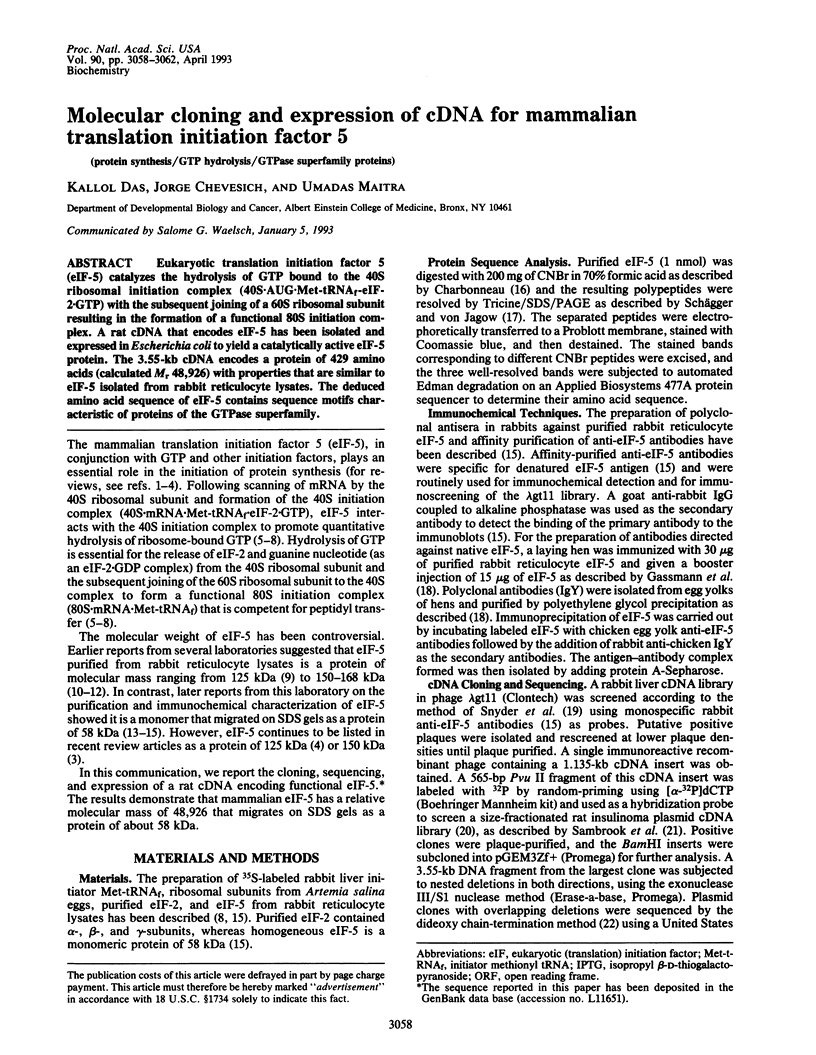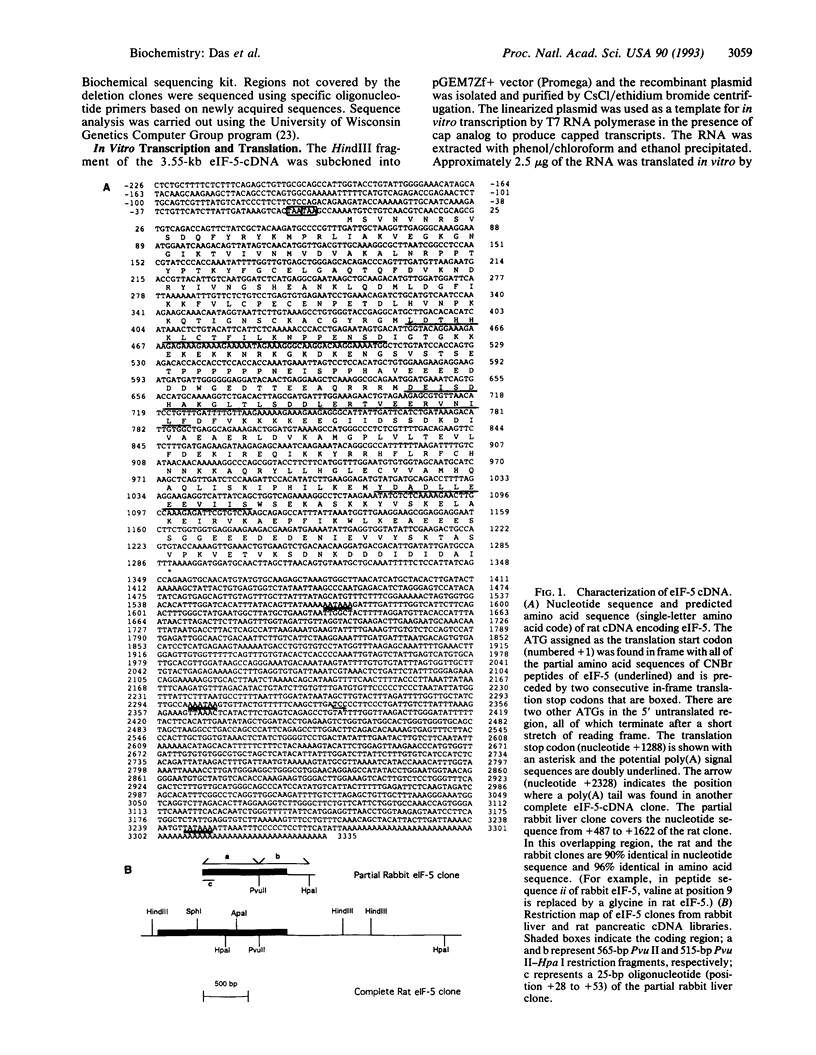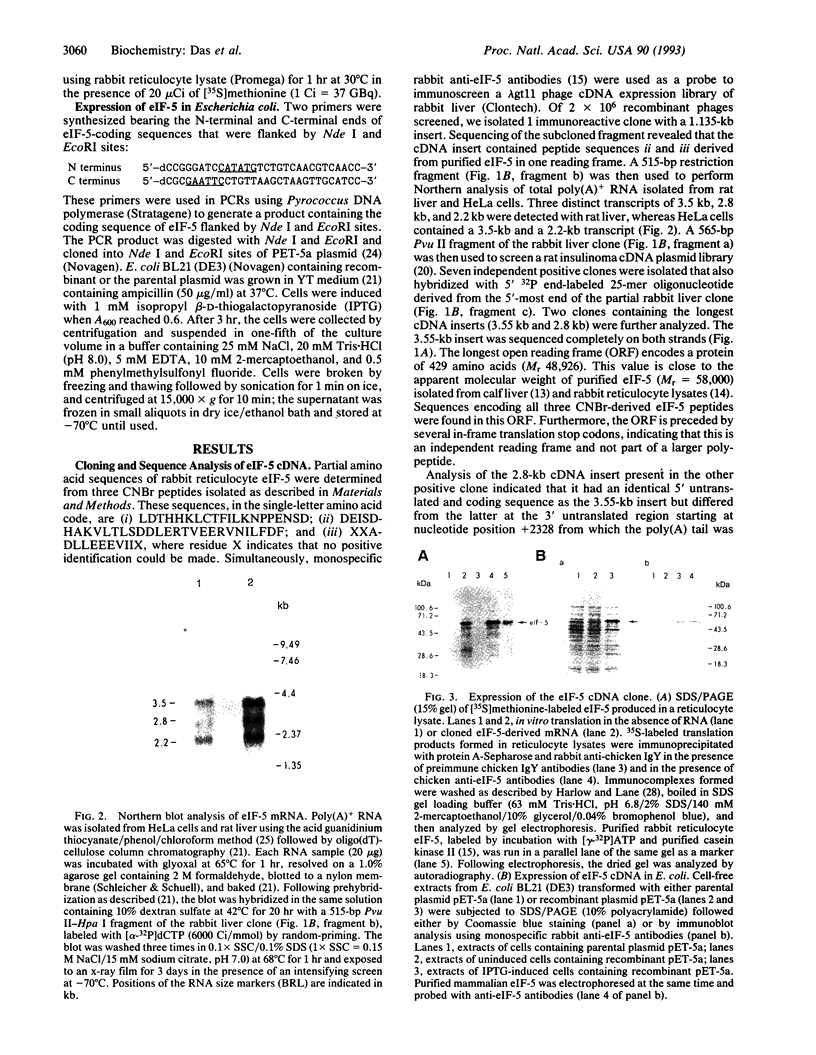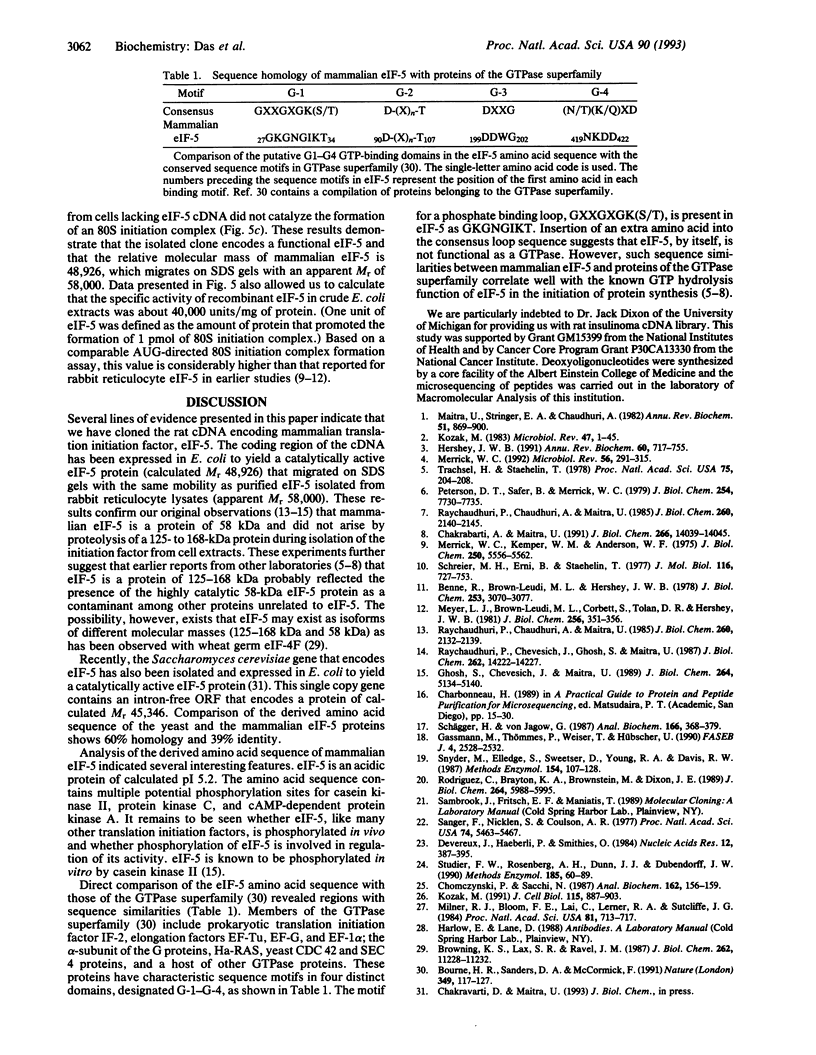Abstract
Eukaryotic translation initiation factor 5 (eIF-5) catalyzes the hydrolysis of GTP bound to the 40S ribosomal initiation complex (40S.AUG.Met-tRNAf-eIF-2.GTP) with the subsequent joining of a 60S ribosomal subunit resulting in the formation of a functional 80S initiation complex. A rat cDNA that encodes eIF-5 has been isolated and expressed in Escherichia coli to yield a catalytically active eIF-5 protein. The 3.55-kb cDNA encodes a protein of 429 amino acids (calculated M(r) 48,926) with properties that are similar to eIF-5 isolated from rabbit reticulocyte lysates. The deduced amino acid sequence of eIF-5 contains sequence motifs characteristic of proteins of the GTPase superfamily.
Full text
PDF




Images in this article
Selected References
These references are in PubMed. This may not be the complete list of references from this article.
- Benne R., Brown-Luedi M. L., Hershey J. W. Purification and characterization of protein synthesis initiation factors eIF-1, eIF-4C, eIF-4D, and eIF-5 from rabbit reticulocytes. J Biol Chem. 1978 May 10;253(9):3070–3077. [PubMed] [Google Scholar]
- Bourne H. R., Sanders D. A., McCormick F. The GTPase superfamily: conserved structure and molecular mechanism. Nature. 1991 Jan 10;349(6305):117–127. doi: 10.1038/349117a0. [DOI] [PubMed] [Google Scholar]
- Browning K. S., Lax S. R., Ravel J. M. Identification of two messenger RNA cap binding proteins in wheat germ. Evidence that the 28-kDa subunit of eIF-4B and the 26-kDa subunit of eIF-4F are antigenically distinct polypeptides. J Biol Chem. 1987 Aug 15;262(23):11228–11232. [PubMed] [Google Scholar]
- Chakrabarti A., Maitra U. Function of eukaryotic initiation factor 5 in the formation of an 80 S ribosomal polypeptide chain initiation complex. J Biol Chem. 1991 Jul 25;266(21):14039–14045. [PubMed] [Google Scholar]
- Chomczynski P., Sacchi N. Single-step method of RNA isolation by acid guanidinium thiocyanate-phenol-chloroform extraction. Anal Biochem. 1987 Apr;162(1):156–159. doi: 10.1006/abio.1987.9999. [DOI] [PubMed] [Google Scholar]
- Devereux J., Haeberli P., Smithies O. A comprehensive set of sequence analysis programs for the VAX. Nucleic Acids Res. 1984 Jan 11;12(1 Pt 1):387–395. doi: 10.1093/nar/12.1part1.387. [DOI] [PMC free article] [PubMed] [Google Scholar]
- Gassmann M., Thömmes P., Weiser T., Hübscher U. Efficient production of chicken egg yolk antibodies against a conserved mammalian protein. FASEB J. 1990 May;4(8):2528–2532. doi: 10.1096/fasebj.4.8.1970792. [DOI] [PubMed] [Google Scholar]
- Ghosh S., Chevesich J., Maitra U. Further characterization of eukaryotic initiation factor 5 from rabbit reticulocytes. Immunochemical characterization and phosphorylation by casein kinase II. J Biol Chem. 1989 Mar 25;264(9):5134–5140. [PubMed] [Google Scholar]
- Hershey J. W. Translational control in mammalian cells. Annu Rev Biochem. 1991;60:717–755. doi: 10.1146/annurev.bi.60.070191.003441. [DOI] [PubMed] [Google Scholar]
- Kozak M. An analysis of vertebrate mRNA sequences: intimations of translational control. J Cell Biol. 1991 Nov;115(4):887–903. doi: 10.1083/jcb.115.4.887. [DOI] [PMC free article] [PubMed] [Google Scholar]
- Kozak M. Comparison of initiation of protein synthesis in procaryotes, eucaryotes, and organelles. Microbiol Rev. 1983 Mar;47(1):1–45. doi: 10.1128/mr.47.1.1-45.1983. [DOI] [PMC free article] [PubMed] [Google Scholar]
- Maitra U., Stringer E. A., Chaudhuri A. Initiation factors in protein biosynthesis. Annu Rev Biochem. 1982;51:869–900. doi: 10.1146/annurev.bi.51.070182.004253. [DOI] [PubMed] [Google Scholar]
- Merrick W. C., Kemper W. M., Anderson W. F. Purification and characterization of homogeneous initiation factor M2A from rabbit reticulocytes. J Biol Chem. 1975 Jul 25;250(14):5556–5562. [PubMed] [Google Scholar]
- Merrick W. C. Mechanism and regulation of eukaryotic protein synthesis. Microbiol Rev. 1992 Jun;56(2):291–315. doi: 10.1128/mr.56.2.291-315.1992. [DOI] [PMC free article] [PubMed] [Google Scholar]
- Meyer L. J., Brown-Luedi M. L., Corbett S., Tolan D. R., Hershey J. W. The purification and characterization of multiple forms of protein synthesis eukaryotic initiation factors 2, 3, and 5 from rabbit reticulocytes. J Biol Chem. 1981 Jan 10;256(1):351–356. [PubMed] [Google Scholar]
- Milner R. J., Bloom F. E., Lai C., Lerner R. A., Sutcliffe J. G. Brain-specific genes have identifier sequences in their introns. Proc Natl Acad Sci U S A. 1984 Feb;81(3):713–717. doi: 10.1073/pnas.81.3.713. [DOI] [PMC free article] [PubMed] [Google Scholar]
- Peterson D. T., Safer B., Merrick W. C. Role of eukaryotic initiation factor 5 in the formation of 80 S initiation complexes. J Biol Chem. 1979 Aug 25;254(16):7730–7735. [PubMed] [Google Scholar]
- Raychaudhuri P., Chaudhuri A., Maitra U. Eukaryotic initiation factor 5 from calf liver is a single polypeptide chain protein of Mr = 62,000. J Biol Chem. 1985 Feb 25;260(4):2132–2139. [PubMed] [Google Scholar]
- Raychaudhuri P., Chaudhuri A., Maitra U. Formation and release of eukaryotic initiation factor 2 X GDP complex during eukaryotic ribosomal polypeptide chain initiation complex formation. J Biol Chem. 1985 Feb 25;260(4):2140–2145. [PubMed] [Google Scholar]
- Raychaudhuri P., Chevesich J., Ghosh S., Maitra U. Characterization of eukaryotic initiation factor 5 from rabbit reticulocytes. Evidence that the initiation factor is a monomeric protein of Mr of about 58,000-62,000. J Biol Chem. 1987 Oct 15;262(29):14222–14227. [PubMed] [Google Scholar]
- Rodríguez C., Brayton K. A., Brownstein M., Dixon J. E. Rat preprocarboxypeptidase H. Cloning, characterization, and sequence of the cDNA and regulation of the mRNA by corticotropin-releasing factor. J Biol Chem. 1989 Apr 5;264(10):5988–5995. [PubMed] [Google Scholar]
- Sanger F., Nicklen S., Coulson A. R. DNA sequencing with chain-terminating inhibitors. Proc Natl Acad Sci U S A. 1977 Dec;74(12):5463–5467. doi: 10.1073/pnas.74.12.5463. [DOI] [PMC free article] [PubMed] [Google Scholar]
- Schreier M. H., Erni B., Staehelin T. Initiation of mammalian protein synthesis. I. Purification and characterization of seven initiation factors. J Mol Biol. 1977 Nov;116(4):727–753. doi: 10.1016/0022-2836(77)90268-6. [DOI] [PubMed] [Google Scholar]
- Schägger H., von Jagow G. Tricine-sodium dodecyl sulfate-polyacrylamide gel electrophoresis for the separation of proteins in the range from 1 to 100 kDa. Anal Biochem. 1987 Nov 1;166(2):368–379. doi: 10.1016/0003-2697(87)90587-2. [DOI] [PubMed] [Google Scholar]
- Snyder M., Elledge S., Sweetser D., Young R. A., Davis R. W. Lambda gt 11: gene isolation with antibody probes and other applications. Methods Enzymol. 1987;154:107–128. doi: 10.1016/0076-6879(87)54073-3. [DOI] [PubMed] [Google Scholar]
- Studier F. W., Rosenberg A. H., Dunn J. J., Dubendorff J. W. Use of T7 RNA polymerase to direct expression of cloned genes. Methods Enzymol. 1990;185:60–89. doi: 10.1016/0076-6879(90)85008-c. [DOI] [PubMed] [Google Scholar]
- Trachsel H., Staehelin T. Binding and release of eukaryotic initiation factor eIF-2 and GTP during protein synthesis initiation. Proc Natl Acad Sci U S A. 1978 Jan;75(1):204–208. doi: 10.1073/pnas.75.1.204. [DOI] [PMC free article] [PubMed] [Google Scholar]




